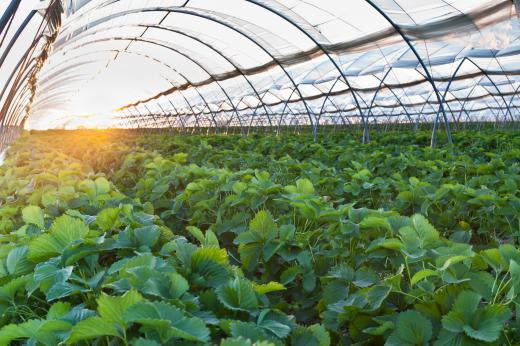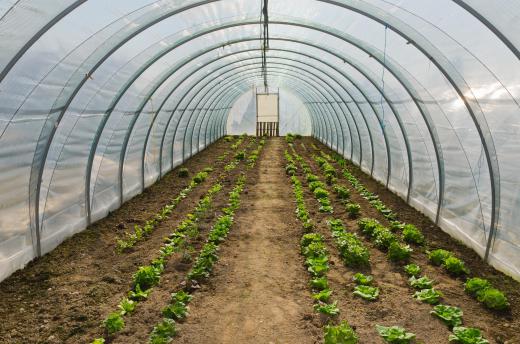How does Greenhouse Glass Work?
Greenhouse glass traps heat energy in the same way that Earth's atmosphere keeps the planet warm: through light wave transformation and through convection of the air inside the greenhouse. Solar radiation reaches the greenhouse, passes through the glass, and gets absorbed by the ground and plants. They convert it to heat energy, which cannot escape through the glass. The air inside the greenhouse is kept warm by convection, which simply means that warmer air near the ground rises, and the cooler air near the ceiling of the greenhouse falls. Because the glass keeps the air trapped inside, the convection process allows the air to absorb more and more heat each time it rises and falls.
The sun provides three basic types of light waves: ultraviolet (UV) waves, visible light waves, and infrared light waves. Each of these light waves has a relatively short wavelength, and will pass easily through most types of glass, including greenhouse glass. Once inside the greenhouse, the waves are absorbed by plants and the ground, where they are used for photosynthesis and transformed into thermal, or heat energy. Because thermal energy has a much longer wavelength than light waves, it cannot pass through the glass, and remains trapped inside. This is referred to as the Greenhouse Effect; it is the same process that keeps the Earth warm, and makes the inside of a car hot on a sunny day.

Along with light wave transformation, another process called convection helps maintain the warmth inside a greenhouse. The air closest to the ground and plants is warmed by the radiating thermal energy; since warm air is lighter than cool air, it naturally rises. In the atmosphere, the warm air will eventually reach a height where it will be cooled again. The glass in the greenhouse traps the air before it can reach this height and cool completely, however. As the air continuously rises and falls within the greenhouse, it maintains its heat and gets slightly warmer each time.

The term "greenhouse glass" commonly refers to both true glass as well as polycarbonate plastics that are also used to construct greenhouses. Glass and clear plastic function in basically the same way, by allowing light to pass through, but trapping heat inside. The choice of whether to use glass or plastic will depend on the type of structure being built, the amount of money available for the project, and the length of time the structure is expected to last. Plastics are generally lighter weight and less expensive, but not as durable to weather and age. Glass greenhouses tend to be semi-permanent structures that will cost more to build initially, but will hold up better over time.

The main difference between greenhouse and regular glass is the type of coating, or glazing, applied to it. Greenhouse glass is typically tempered for safety, which means that it has been laminated, similar to a car windshield; if it breaks, it crumbles into small pieces with relatively smooth edges that are less likely to cut than large, jagged shards. Tempered glass is highly recommended for greenhouse applications, since the glass will be installed overhead and subjected to wind, hail, and stress from snow weight in colder climates.
In addition, this type of glass may have a low-E glazing applied. Low-E glazing is a thin, semi-transparent layer of metal that reflects most UV and some infrared light back into the atmosphere, while still allowing visible light to penetrate into the greenhouse. By blocking the more intense UV waves, low-E glass can protect tender seedlings from receiving too much solar radiation. It also helps to maintain a more constant temperature within the greenhouse by blocking some incoming infrared, or heat waves. With proper ventilation, low-E glass can help prevent the greenhouse from getting overheated.
AS FEATURED ON:
AS FEATURED ON:













Discussion Comments
Laminated glass is made by pressing two or more sheets of glass together and using a type of plastic in between. This will allow the glass to stay together if it is broken. All American autos have this type of glass in the windshield. Tempered glass is made by subjecting the glass to a temperature of about 1200 degrees Fahrenheit and then blowing the surface with much cooler air.
That process strengthens the glass. Tempered glass
can be laminated, but laminated glass cannot be tempered. Both types are approved safety glass. --JR, California
Laminated glass (used in modern car windscreens) is made by bonding a layer of touch clear plastic sheet between glass sheets. Depending on the impact, the plastic can limit damage to a single layer and prevent the glass cracking.
Tempered glass (superseded by laminated in windscreen use) shatters into small, relatively smooth pieces of glass due to a tempering (heating and cooling) process which locks mechanical stresses into the pane. Both types are referred to a safety glass.
Tempered glass can't be drilled to accept mechanical fixings after tempering.
You can cool your house by radiating heat to cold outer space if you get clear evenings without cloud cover. Works even in Florida. Your dome will need an inner part you live in and an outer part to radiate heat at night and the part in between acts to transfer heat by day to the outside with some simple fans and by night it takes your living area warmth in the house into the roof space so it can contact the cooler radiating to outer space through the roof. Sounds weird but is proven by Arabs and Indians for centuries. You need though to have clear, starry nights for this to work.
So hi, I live in the Caribbean where it is often sunny.
I am building a house that I would like to be in the shape of a dome.
Challenge: I need the inside of the dome to be cool, not hot, in our case very hot, from the sun...and I need it to breathe...in other words...how do Ikeep everything inside cool and breathing...with an eye to ecological sustainability?
Post your comments